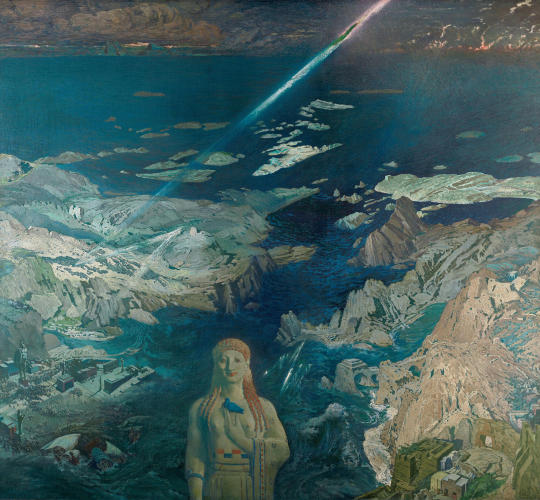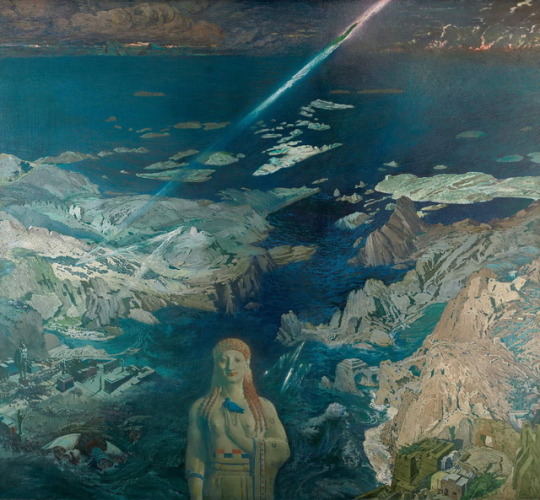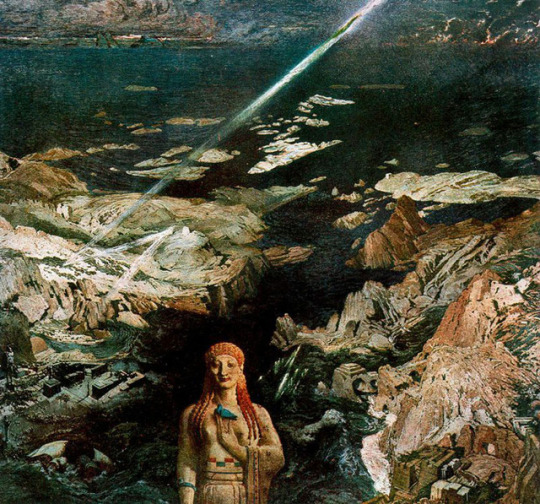#Terror Antiquus
Text

‘Terror Antiquus’ by Léon Bakst, c. 1908.
#Léon Bakst#vintage art#classic art#art#art history#old art#painting#art details#vintage#oil painting#moody art#symbolism
101 notes
·
View notes
Text
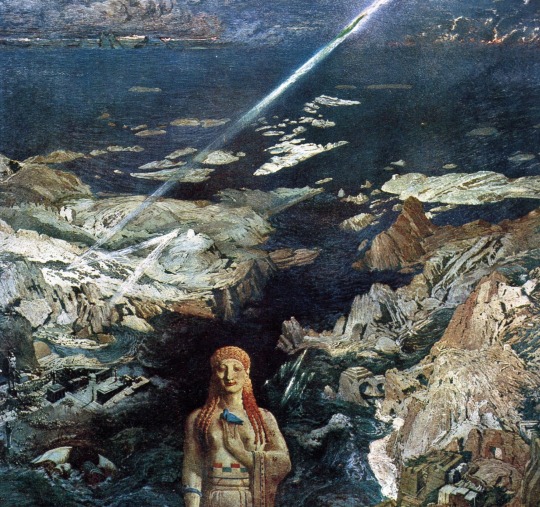
Terror Antiquus (Ancient Horror) by Léon Bakst (1908)
81 notes
·
View notes
Text

Terror Antiquus (1908) by Léon Bakst (1866–1924), Russian painter and scene/costume designer for the famous Ballets Russes
Государственный Русский музей
32 notes
·
View notes
Photo




Dreadnought entering Planet 4′s atmosphere looks like this and as David leads the landing party to the city the shape of the land with the river down the middle is like the path through the engineer corpses:
Terror Antiquus by Léon Bakst 1908
Terror Antiquus depicts the death of an ancient civilization; in the midst of a natural disaster. In the pagan conception of the world, the "Ancient Terror" is the horror of life in a world under the domination of dark and inhuman destiny, the horror for we who are helplessly submissive to destiny without hope of escape; Or horror at the chaos and nothingness to which we are irremediably drawn, which will be fatal.
Perhaps we could free ourselves from this terror. Even with some sort of religious faith like Christianity, Judaism, or other religions or philosophies which bring us a possibility of a new conception of destiny. But the de-christianisation of culture has condemned him to return to this terror.
The Russian poet and philosopher Viatcheslav Ivanovich Ivanov considers that in choosing to call his work "Terror Antiquus," the painter wants to highlight the horror of destiny, he wants to show that not only all that is human, but also all that is divine was perceived as relative and passing by the ancients. The only certainty is that of the existence of destiny, or the indispensable "necessity of the world”
The scene is a symbolic of the fallen Engineer Empire, and type of horror this movie is supposed to be, the horror at the chaos and nothingness. This is immediately highlighted in the darkness of space when Captain Branson’s body is flushed out the airlock. Daniels brings this up when she says she cannot hear anything, no birds, no animals, nothing.
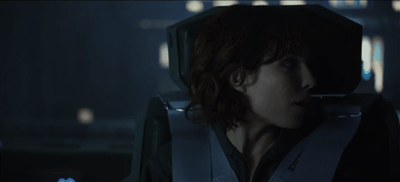
In Prometheus David also repeats the Lawrence of Arabia line: "There is nothing in the desert and no man needs nothing."
In the original move, the entire quote:
"I think you are another of these desert-loving English: Doughty, Stanhope, Gordon of Khartoum. No Arab loves the desert. We love water and green trees, there is nothing in the desert. No man needs nothing." - Prince Feisal, Lawrence of Arabia
The quote echoes the conclusion of the movie -- Peter Weyland discovers that the journey to the "desert" of LV-223 yielded nothing.
In fact, Weyland's final words are "There's nothing". David then answers "I know... Mr. Weyland, have a safe journey".
After Weyland's final words, the android seems to be bidding farewell to his father, who is leaving for the desert... where there's nothing, and where he won't be needing anything else.
Best viewed on desktop
Prometheus Analysis | Alien Covenant Analysis | Mythology Prequels Project | The Crossing Analysis | Advent Analysis
#Terror Antiquus#Planet 4#Nothingness#destiny#analysis#film analysis#art#heaven#hell#alien covenant analysis#alien covenant#alien#alien: covenant#Dante's inferno#dante alighieri#dante#the divine comedy#purgatory#horror#space#Léon Bakst#Leon Bakst#science fiction#scifi#alien prequel#alien film#alien franchise#weyland yutani#film symbolism#cinematography
10 notes
·
View notes
Photo

Léon Bakst, Terror Antiquus (1908)
Лев Само́йлович Бакст (Лейб-Ха́им Изра́илевич Розенберг), Древний ужас
#Russian art#Russia#Belarussia#XX century#Léon Bakst#Terror Antiquus#painting#Symbolism#Ancient Greece
27 notes
·
View notes
Text
Union of Russian Artists (1903-1923)
1903 saw the foundation of the Union of Russian Artists, an exhibiting society comprising artists from the St Petersburg based Mir iskusstva (World of Art) and former members of the progressive and democratic group known as the Wanderers (Peredvizhniki). The World of Art movement had become disillusioned, as the Pre-Raphaelites had before them, with the anti-aesthetic nature of modern industrial society, seeking to restore and consolidate neo-romantic Russian artists under one flag - notable members included Alexandre Benois and Léon Bakst. Break away members of the Wanderers included Valentin Serov and Abram Arkhipov.

This Russian charm is modelled as an artist's palette, complete with gem-set paint patches. The quality is superb, as expected with Imperial Russian jewellery, it's crafted in 56z (14 karat) gold with an inscription 9th/21st March 1903 (at the time Russia used the Julian calendar, while the rest of Europe had changed over to the Gregorian, meaning the dates were 13 days out of sync). Was it commissioned to commemorate the founding of the Union of Russian Artists? Quite possibly. We'll never know for sure.

The society's explicit purpose was to "to promote Russian art and to provide members sell their art works", but it also sought to break away from the old forms through self organised exhibitions, not controlled by juries. It ran 18 exhibitions in total from 1903 to 1923, the most successful being the 11th (1913/14) which hosted over 25,000 viewers and made over 70,000 roubles from the sales of works (over $2 million in today's money).
Artists from the two groups embraced widely divergent aesthetic stances ranging from lyrical landscapes by Nikolay Klodt and Arkady Rylov, to the impressionistic paintings of Igor Grabar, symbolist works by Viktor Borisov-Musatov, and experimental works by Mikhail Brubel and V. Serov. The Union of Russian Artists didn't achieve stylistic unity until after the 7th exhibition (1910), when 17 of the St Petersburg artists, led by Benoit, departed citing artistic differences and going on to re-form the World of Art. From then until its dissolution in 1923, the members mainly produced landscapes and genre scenes characterised by a democratic tendency and an interest in the Russian landscape and the distinctly original features of Russian life.

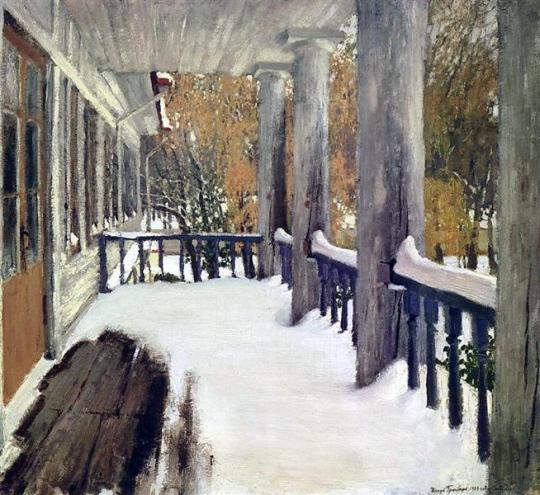
Left: Viktor Borisov-Musatov, Ghosts (1903)
Right: Igor Grabar, September Snow (1903)


Left: Konstantin Yuon, The Night. Tverskoy Boulevard (1909)
Right: Valentin Serov, The Rape of Europa (1910)

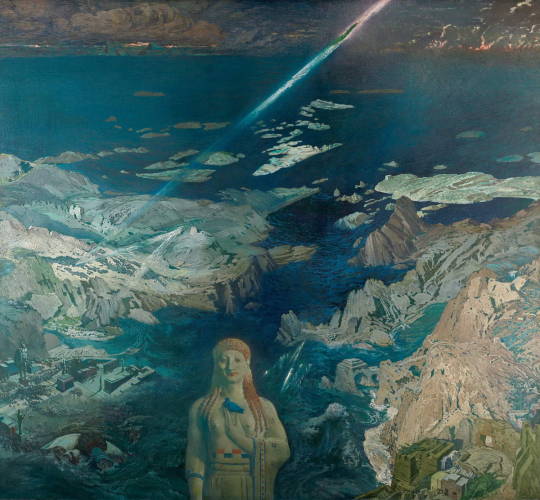
Left: Mikhail Vrubel, Six-winged Seraph (Azrael) (1904)
Right: León Bakst, Terror Antiquus (1908)
11 notes
·
View notes
Photo
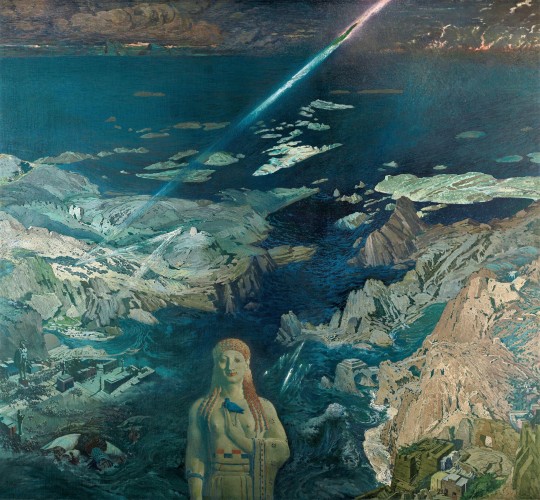
Léon Bakst (Russian, 1866-1924)
Terror Antiquus ,1908
254 notes
·
View notes
Photo

Terror Antiquus by Léon Bakst, 1908 (Russian Museum, St. Petersburg)
20 notes
·
View notes
Photo

Leon Bakst — Terror Antiquus ['Ancient Horror'], 1908.
Painting: oil on canvas, 250 x 270 cm. State Russian Museum.
In 1907, Leon Bakst visited Greece in the company of Valentin Serov, sketching the country’s ancient monuments and Mediterranean nature and reading the works of her ancient philosophers and writers. This helped to form an image of Greece and Greek culture in his imagination, one both concrete and simultaneously abstract. This duality can be seen in Terror Antiquus, in which the artist uses symbols to express the apocalyptic nature of the modern age. He depicts the destruction of an ancient city and its inhabitants. Bakst scrupulously reproduces a number of ancient edifices — the Lion Gate in Mycenae, the ruins of the palace at Tiryns, and the Athenian Acropolis.
The natural landscape in the picture is a generalisation and also reflects Bakst’s study of Hellenic geography. The image of the Archaic kore presiding over the chaos and personifying the inexorable force of human fate is equally concrete and just as abstract.
Although the critics found many faults in Terror Antiquus, Bakst’s painting enjoyed great success at the Salon d’Automne in Paris. It was awarded a gold medal at the Exposition Universelle in Brussels in 1910. Source
Classical Themes
Romanticism
1900s
#leon bakst#terror antiquus#date:1908#1900s#blue#greece#greek#scapes#landscape#idol#classical themes#classical theme#polytheism#classical#romanticism#20th century#20th century art#early 20th century#russian artists#painting
30 notes
·
View notes
Video
vimeo
Alien Covenant Delve in deeper into the artistic, mythological and symbolic meaning of each scene, set and script. Find out how rich this tapestry of Horror, Science and Art may be one of the most meaningful pieces of cinema for the 21st Century and beyond.
-Patch-
USCSS Covenant Weyland Yutani Patch
-Film Style-
Aeschylus
-Advertising-
Alien: Covenant Poster
Prologue: The Crossing
The Last Supper
Meet Walter
Nature Boy
Under the Water
-Mythology-
Epimetheus - Walter
Prometheus - David & Elizabeth Shaw
Pyrrha - David
Janus - David
-Facts-
How old is David in Alien: Covenant
-Names, Words & Meanings-
Meaning of the name Daniels
Meaning of the name Janet(Daniel’s First name)
Meaning of the name Walter
The Meaning of David 2 https://muthur9000.tumblr.com/post/168426179020/so-as-you-may-know-david-8s-character-shares-many The meaning of Origae
The meaning of Origae 2 https://muthur9000.tumblr.com/post/163394139855/names-meanings-origae The meaning of Wagner
-Alien: Covenant Prologue-
The Nativity
David
Throne Chair
-Art-
Terror Antiquus - Lander Entering Planet 4′s Atmosphere
Satan Descends Upon Earth - USCSS Covenant In Orbit Around Planet 4
Lost & Virgil Leads Dante Onward - Covenant Ground Crew Ascends Mountain
The Tempest of Hell - Covenant Crew Discovers Crashed Juggernaut
Remember Purgatory - Covenant Crew Gathered At Base Of Mountain
The Great Red Dragon & Woman Clothed In Sun - Ledward, Rosenthal & Oram’s Death
Satan by William Blake - David raises his arms
Three Beasts & Beatrice - Neomorph & Protomorph Deaths & David
Apocalyptic Procession - Journey To The Engineer City
Satan presides over the Avaricious & the Prodigal - Engineer Citadel
The Sistine Chapel, Time: The Flood by Michelangelo Buonarroti - The Engineer Cathedral
Bridge over Chaos - Crossing The Plaza Extended
The Courts of God & Dante and Virgil Approaching The Entrance To Hell - Crossing The Plaza
Isle of the Dead - Elizabeth Shaw’s Garden
Pandemonium & the 7th Plague - Crossing The Plaza
Stairway to Heaven - Engineers Run For Their Lives
Ophelia - Rosenthal’s Death
Paradise - Prometheus, Meet Walter & Alien: Covenant Mountains
The Vivisected Engineer - David’s Vivisected Engineer
Casting of the Rebel Angels into Hell - The Crossing Part I
Souls Circling to form Letters - The Crossing Part II
Rings of Glowing Souls - The Crossing Part III
Gaze upon Hell - The Crossing Part IV
Whirlwind of Lust - The Crossing Part V
Punishment of Thieves - The Crossing Part VI
-Illustrations-
David’s Drawings of Dr Elizabeth Shaw
Sabrina and Her Nymphs by William Etty
Study for the Head of Leda by Leonardo Da Vinci
-Poetry & Literature-
Robinson Crusoe - David
Fog by Carl Sandburg - “Me and Fog on little cat feet” - David
Oh, Whistle, And I’ll Come To You, My Lad by M. R. James - “Whistle and I’ll Come” - David
“Blow on the nostrils of a horse and it will be yours for life, but you have to get close, you have to earn it’s trust” - David, Alien: Covenant
-Homages-
Xenomorph attacks David/Walter in screen - Xenomorph attacks Dr.Gediman Alien: Resurrection
The Last Supper - Dinner scene in Alien 1979
Tennessee Fact - Homage to Stanley Kubrick
-Blu-ray Extra’s-
Advent
Twinkle twinkle little star - Walter in the Greenhouse
Best viewed on desktop
Prometheus Analysis | Alien Covenant Analysis | Mythology Prequels Project | The Crossing Analysis | Advent Analysis
#vimeo#alien covenant#art#yutani assets#alien movie#alien film#alien franchise#weyland yutani#sir peter weyland#david 8#david8#michael fassbender#elizabeth shaw#meredith vickers#prometheus movie#alien: covenant#walter alien covenant#david alien covenant#dante alighieri#the divine comedy#origae-6#wagner#entry of the gods#das rhinegold#carl sandburg#poetry#byron#shelly#frankenstein#william etty
42 notes
·
View notes
Photo
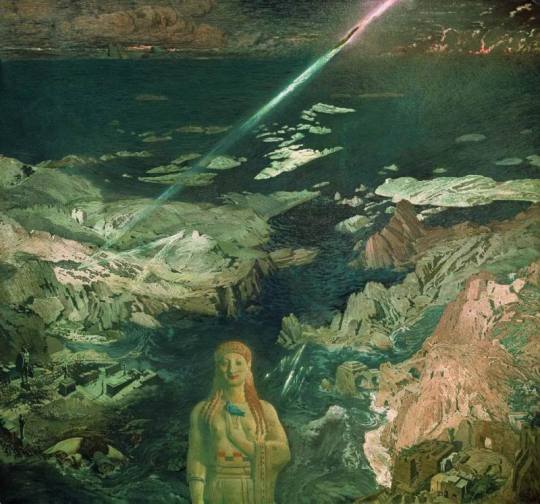
Léon Bakst - Terror Antiquus (1908)
335 notes
·
View notes
Photo
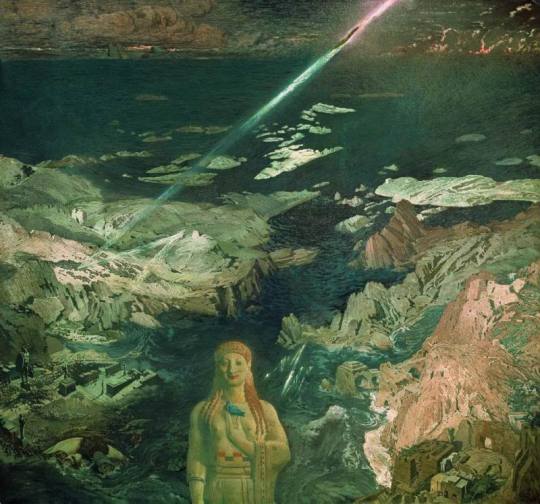
#Léon Bakst#Terror Antiquus#Art nouveau#Symbolism#art#An ancient horror#landscape#landscape art#portrait#mountains#seascape#Leon Bakst#Лео́н Бакст#Лев Розенберг#Lev Rosenberg#Les Ballets russes#Ballets russes#Mir iskusstva#Мир иску́сства#World of Art#Modern#Модерн#Ancient horror#Древний ужас#Atlantis#Archaic period#sculpture#kore#Ancient Greek art#Κόρη
7 notes
·
View notes
